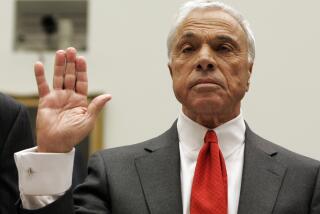S&L; Industry Ebullient as Profits Soar : Thrift Executives Voice Optimism for Continued Gains
- Share via
DALLAS — Whether or not it falls under the heading of whistling your way past a graveyard, as some skeptics maintain, the nation’s thrift institutions convening here last week radiated an optimism bordering on euphoria--long absent from the industry.
About 6,000 savings and loan company executives and their guests attending the 93rd annual convention of the U .S. League of Savings Institutions had reason for cheer in the record profits that will be chalked up by the S&Ls; for 1985--a booming $5 billion, as against a puny $1.1 billion the previous year.
No less encouraging: Authoritative estimates by industry leaders that the “meat” that is the staple diet of the thrift industry--real estate--will continue to become even more palatable with inflation remaining low (in the 3.5% to 4% range in the estimate of Walter W. Heller, Regents Professor of Economics at the University of Minnesota) and if interest rates continuing their decline.
8% Rate Seen by Spring
Only in the degree of their optimism did key speakers reflect differences. Donald Hovde, one of three members of the powerful Federal Home Loan Bank Board, put the prime rate--the interest rate charged large corporate borrowers and the bellwether for all consumer interest rates, and which now stands at 9.5%--at 9% by the end of the current year and at 8% next spring.
“But,” Hovde said in a later discussion, “once the 9% barrier is penetrated anything can happen, and I wouldn’t be surprised to see the prime go down to 7%.”
Even under his more conservative scenario, though, Hovde added, 30-year fixed interest mortgage rates--now hovering around 12.15%--should drop to about 11% next year.
Recession Possible
James W. Christian, chief economist for the U .S. League of Savings Institutions, however was less bullish and felt the prime would stubbornly stay above the 9% level and that the likelihood of a recession next year can’t be completely ruled out.
The overriding optimism that prevailed here, notwithstanding, there were still undercurrents of caution largely reflecting:
--The thrift industry’s recent brush with catastrophe;
--Rumbles in the economy that could have difficult-to-assess impacts on savings patterns, the fuel that keeps it going;
--Its continued uneasy role as a newly deregulated industry.
Last Record Year for Profits
Record profits this year, or not, the S&Ls; are only a hand-span away from 1981, when it had losses of $4.6 billion, and 1982, when it had losses of $4.1 billion. And, lest this year’s profit of $5 billion be through too rosy a pair of eyeglasses, John B. Zellars, this year’s chairman of the league, reminded his membership, it should be remembered that, in 1978--the last record year for profits of $3.9 billion--the return on average assets was 0.81% and the return on equity was 14.84%.
For the first half of 1985--big dollar figures, or no big dollar figures--the return on assets on an annualized basis was only 0.38%, or less than half the return in 1978, Zellars cautioned.
And, black ink or no black ink, the league’s chairman reminded his listeners, of the nation’s 3,400 S&Ls;, about 10% have a net worth below what regulators consider safe, and are thus considered insolvent, or expected to become so within a year.
Sobering too, Hovde admitted, were recent figures showing the average American’s savings rate--about 2% of income--is the lowest recorded since the Depression of the 1930s.
Lingering Aftershocks
“We’ll just have to wait and see. We can have a real drying up of funds,” Hovde said, “if this doesn’t bounce back up to the normal range of about 5.5%. Actually, I think it’s a freak, an anomaly, brought about by all of those heavily-discounted automobile financing plans, but, we’ll see.”
The nagging troubles that persist among the S&Ls;, industry spokesmen here agreed, are both lingering aftershocks of the 1981-82 credit squeeze, and sky-high interest rates that trapped virtually all S&Ls; and, in large measure, are also products of congressional deregulation in ’82 that was supposed to rescue them.
The same deregulation that also encouraged some high-flying S&Ls; to wander far afield from real estate financing and into risky venture with little or no, expertise.
And, in the backlash of this, the outspoken and controversial chairman of the Federal Home Loan Bank Board, Edwin J. Gray, has found himself in the eye of a storm, and the regulatory agency he heads, critics charge, is in disarray as key personnel abandon the Board amid persistent rumors of Gray’s imminent resignation.
Rescue Fund
At the center of it all: Gray’s often-quoted misgivings about the ability of the Federal Savings and Loan Insurance Corp., (the FSLIC) to continue bailing out the depositors of failed S&Ls; without levying substantial, supplementary risk premiums on all FSLIC-insured institutions.
Already, they are being assessed to create a rescue fund based on one-eighth percent of assets, and there is natural resentment at what they see as penalization for further amounts to bail out the high flyers.
While dismissing the resignation rumors at his Tuesday address before the league, Gray did, however, announce the formation of a newly chartered agency, to be called the Federal Asset Disposition Assn. to wring top dollar out of assets that the FSLIC has taken over in its liquidations.
To be based in Denver, the new agency would, in effect, set up a private corporation--staffed with experienced personnel that can be recruited without the restraints imposed by federal limitations on salaries and incentives.
Rumors at the convention placed the salary that would be offered to the still-to-be-recruited chief executive officer of the new mop-up operation at $400,000 a year.
More to Read
Inside the business of entertainment
The Wide Shot brings you news, analysis and insights on everything from streaming wars to production — and what it all means for the future.
You may occasionally receive promotional content from the Los Angeles Times.










